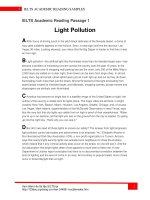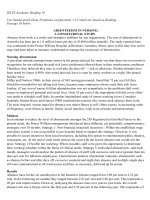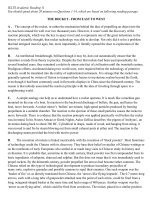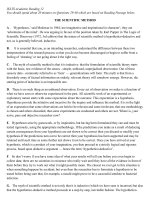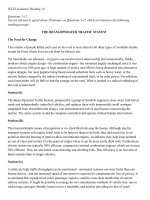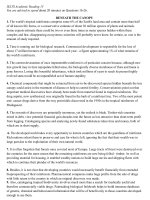IELTS academic reading 16
Bạn đang xem bản rút gọn của tài liệu. Xem và tải ngay bản đầy đủ của tài liệu tại đây (96.91 KB, 4 trang )
IELTS Academic Reading 16
You are advised to spend about 20 minutes on Questions 1-15.
DESTINATIONS FOR INTERNATIONAL ENGLISH STUDENTS
Paragraph (i)
At any given time, more than a million international students around the world are engaged in the study
of the English language in a predominantly English-speaking country. The five most popular
destinations, in order of popularity, are the U. S., Britain, Australia, New Zealand, and Canada. The
reasons for choosing to study English abroad differ with each individual, as do the reasons for the choice
of destination.
Paragraph (ii)
Numerous studies conducted in Britain and the United States show that the country of choice depends to
a large extent on economic factors. While this should not provoke much surprise, careful analysis of the
data suggests that students and their parents are most influenced by the preconceptions they have of the
countries considered for study abroad, which, in turn, influence the amount they or their parents are
prepared to outlay for the experience. The strength of international business connections between
countries also gives a good indication of where students will seek tuition. In the main, students tend to
follow the traditional pattern of study for their national group.
Paragraph (iii)
The United States attracts the most diverse array of nationalities to its English language classrooms - this
heterogeneity being largely due to its immense pulling power as the world's foremost economy and the
resulting extensive focus on U.S. culture. Furthermore, throughout the non-European world, in Asia and
North and South America especially, the course books used to teach English in most elementary and high
schools introduce students to American English and the American accent from a very early age. Canada
also benefits from worldwide North American exposure, but has the most homogenous group of students
- most with French as their first language. Before furthering their English skills, students in Europe study
from predominantly British English material; most Europeans, naturally, opt for neighbouring Britain,
but many Asian, Middle-Eastern, and African students decide upon the same route too.
Paragraph (iv)
Australia and New Zealand are often overlooked, but hundreds of thousands of international students
have discovered the delights of studying in the Southern Hemisphere. The majority are Asian for reasons
that are not difficult to comprehend: the proximity of the two countries to Asia, (Jakarta, the capital of
Australia's closest Asian neighbor, Indonesia, is only 5506 kilometers from Sydney), the comparatively
inexpensive cost of living and tuition, and, perhaps of most importance to many Asian students whose
English study is a prelude to tertiary study, the growing awareness that courses at antipodean universities
and colleges are of an exceptionally high standard. In addition, revised entry procedures for overseas
students have made it possible for an increasing number to attend classes to improve their English for
alternative reasons.
Paragraph (v)
Australia and New Zealand have roughly the same mix of students in their language classrooms, but not
all students of English who choose these countries are from Asia. The emerging global consciousness of
the late twentieth century has meant that students from as far as Sweden and Brazil are choosing to
combine a taste for exotic travel with the study of English 'down under' and in 'the land of the long white
cloud'. But even the Asian economic downturn in the 1990s has not significantly altered the demographic
composition of the majority of English language classrooms within the region.
Paragraph (vi)
Nor have the economic problems in Asia caused appreciable drops in full-time college and university
attendances by Asian students in these two countries. This is partly because there has always been a
greater demand for enrolment at Australian and New Zealand tertiary institutions than places available to
overseas students. In addition, the economic squeeze seems to have had a compensatory effect. It has
clearly caused a reduction in the number of students from affected countries who are financially able to
study overseas. However, there has been a slight but noticeable shift towards Australia and New Zealand
by less wealthy Asian students who might otherwise have chosen the United States for English study.
Paragraph (vii)
The U.S. and Britain will always be the first choice of most students wishing to study the English
language abroad, and it is too early to tell whether this trend will continue. However, economic
considerations undoubtedly wield great influence upon Asian and non-Asian students alike. If student
expectations can be met in less traditional study destinations, and as the world continues to shrink, future
international students of English will be advantaged because the choice of viable study destinations will
be wider.
Questions 1-4
You are advised to spend about 5 minutes on Questions 1-4.
Complete the missing information in the table below by referring to Reading Passage 1
"Destinations for International English Students".
Write your answers in boxes 1 - 4 on your Answer Sheet. The first one has been done for you as an
example.
U.S.
Britain
Australia
New Zealand Canada
order of popularity
1st
Ex:… 2nd…
3rd
4th
5th
type of English in course
books used in this country
American
1………..
2……..
not given
not given
1
2
3…….
Equal 3
5
student heterogeneity
(1 = most heterogenous
5 = least heterogenous)
You are advised to spend about 5 minutes on Questions 4 -9.
Choose the most suitable heading from the list of headings below for the seven paragraphs of Reading
Passage 1 "Destinations for International English Students". Write your answers in boxes 5 - 10 on your
Answer Sheet.
List of Heading
A. Heterogeneity in the language classroom
B. Enrollment demand in Australia & New Zealand.
C. Reasons for the choice of destination
D. The attractions of studying in the antipodes
Example: E. Conclusion
F. Additional student sources
G. Student destinations
Q4. Paragraph (i) ...............
Q5. Paragraph (ii) ...............
Q6. Paragraph (iii)............... Q7. Paragraph (iv)...............
Q8. Paragraph (v)...............
Q9. Paragraph (vi)...............
Example: Paragraph (vii) ...... E..............
Questions 10-15
You are advised to spend about 10 minutes on questions 10 -15.
Refer to Reading Passage 1 "Destinations for International English Students", and look at the statements
below.
Write your answers in boxes 10 -15 on your Answer Sheet.
Write T if the statement is True; F if the statement is False; N if the information is Not Given in the text.
Example: There are presently more than 1,000,000 foreign students of English abroad
T
F N
Q10. Study destination choices are mostly influenced by proximity to home
T F
N
Q11. Students who wish to study business will probably study English overseas.
T
F
N
Q12. Students of the same nationality usually make similar study choices.
T
F
N
Q13. English language classrooms in the U.S. have the widest range of student nationalities.
T F
N
Q14. Standards at Australian and New Zealand tertiary institutions are improving.
T F
N
Q15. Despite the 1990s Asian economic crisis, Asian students still dominate the English language
classrooms of Australia and New Zealand.
T F
N
Answer:
1. British 2. not given 3. (equal ) 3 4. G
12. T 13. T 14. N 15. T
5. C
6. A 7. D 8. F 9. B 10. F 11. N

